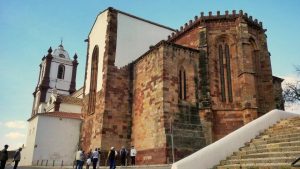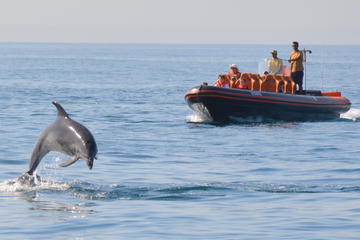
Plan your next adventure to Porto, the breathtaking coastal destination located in northwestern Portugal. This medieval city is filled with majestic bridges, narrow cobbled streets, and lots of port wine. The architecture is a diverse mix of old and new, making it a beautiful city.
While many of the attractions in the city do cost to visit, there are plenty more that are free to enjoy. You do not have to break the bank to have a fantastic vacation. Instead, experience some of the top 9 free things in Porto.
While you are out taking in the sights, secure your bags with a luggage storage service to ensure your things are kept safe. Most places do not allow large bags, so you will definitely want to stow your things before heading to these attractions.
Avenida dos Aliados
Avenue of the Allies is the main thoroughfare and is lined with trendy shops, quaint cafes, hotels, and adorable boutiques. The central plaza, Liberdade Square, along the avenue has been fully restored and is the perfect place to relax with a cup of coffee.
Liberdade Square also is host to many arts and comic festivals throughout the year. Street performers can be seen doing impromptu comedy and dance. Check out the marble town hall and the amazing statue of King Pedro IV on his horse.
Dom Luís I Bridge
Take a stroll over the Douro River from Porto to Vila Nova de Gaia and explore the shops and boutiques along the way. The Dom Luís I Bridge is free to walk across. Grab a cup of coffee and take a nice leisurely walk.
The bridge was completed in 1886 and at that time was the longest arched bridge in the world. The bridge has a lower level for vehicles and an upper level for the city’s metro. Pedestrians are able to walk along both levels.
Jardins do Palácio de Cristal
It is free to visit these amazing landscaped gardens, designed during the 19th century. Well-manicured paths take you by beautiful topiaries and fountains, and there are even great views of the Douro River.
Bring your camera along for some amazing nature shots and selfies as you meander through the different paths. Be on the lookout for a peacock or two that are known to strut through the gardens from time to time.
Sé do Porto
Perched high above the city on a hill is the Porto Cathedral, also known as Sé do Porto. The cathedral was built sometime between the 12th and 13th centuries and is the biggest church in the city. It is also one of the oldest buildings in Porto.
The façade is almost fortress-like and can look a little intimidating but looks fantastic in photos. Check out the stained glass windows and ancient sculptures that date back to ancient times.
Estacão de São Bento
Located where a Benedictine monastery once stood, the São Bento Railway Station was completed in 1916. The most notable thing about this train station is not the trains coming and going down the tracks.
Be sure to bring your camera for photos of the painted blue tiles called azulejo. With over 20,000 azulejo tiles, artist Jorge Colaco created a mural depicting some historic events in Porto’s history. The mural was completed between 1905 and 1916.
Mercado do Bolhão
Spend the morning soaking up the smells of freshly baked bread, earthy vegetables, sweet fruits, and pungent cheese at the Bolhão Market. Vendors set up in this open-air market and hawk their goods, so be ready to haggle if you are doing some shopping!
The market is one of the oldest in the city and is filled with vibrant energy. You do not have to purchase anything to visit the market and can even sometimes score some scrumptious samples.
Parque da Cidade do Porto
Visit one of the biggest parks in Porto for free. Porto City Park has over 200 acres of lush green space and is the perfect place to unwind after a day of sightseeing. There are more than six miles of hiking and biking trails as well as amazing picnic spots under magnificent shade trees.
The park even extends to the Atlantic Ocean and offers access to some of the sandy beaches. Spend a few hours lounging in the sunshine or splashing in the waves. Admission to the park is free but attractions in the park do cost to enter.
Capela das Almas
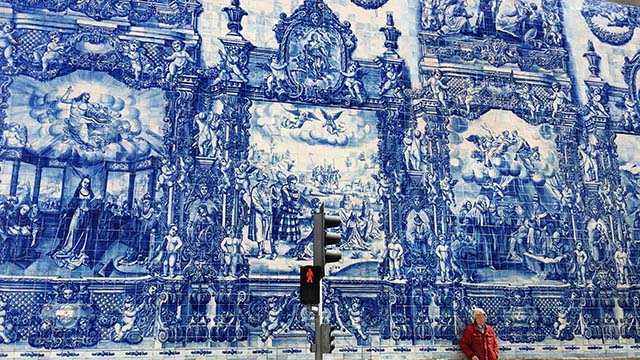
The Chapel of Souls, or St. Catherine Chapel, is most famous for the blue and white painted tiles that make up various scenes from the lives of some of the saints. There are 16,000 azulejo tiles and is an absolute must-see.
Because the murals are on the exterior of the church, you can view the tiles for free. The church itself was built during the 18th century but the tiles were not added until the beginning of the 20th century.
There are certain times you can enter the church free, check their website for days and times so you can fully experience all the Chapel of Souls has to offer for free.
Cais da Ribeira
Located near the Dom Luís I Bridge, you can easily wander along this riverfront promenade after visiting the bridge. Wear comfortable shoes so you can enjoy the walk through one of the trendiest parts of Porto.
It is free to walk along the Cais da Ribeira and if you visit during the day you can even see the adorable pastel houses that face the water. They are a sight you do not want to miss.
Put your wallet away and enjoy these top 9 free things in Porto while you are visiting. Grab your friends and start exploring the city, starting with the free things you can do. Afterwards, select attractions with a fee so you don’t break the bank upon arrival. Bring along your camera and your sense of adventure!
Resources:
https://www.diocese-porto.pt/pt/catedral-do-porto/
https://www.cp.pt/passageiros/pt/consultar-horarios/estacoes/porto-sao-bento



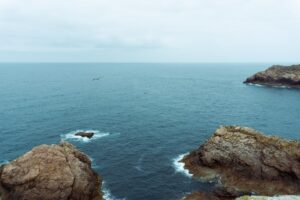

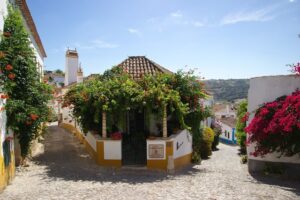
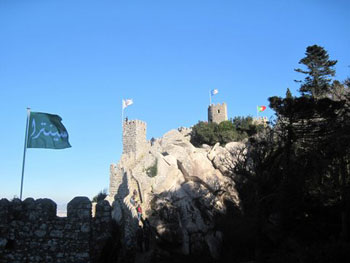 Sintra, Portugal
Sintra, Portugal Once I pay for my ticket at the ticket office housed in a trailer, I follow the signs and go through the turnstile. I walk past some workers manning a zip line that allows them to bring up wood planks and other constructions materials from down below for restoration work at the castle. I follow the signs along the path.
Once I pay for my ticket at the ticket office housed in a trailer, I follow the signs and go through the turnstile. I walk past some workers manning a zip line that allows them to bring up wood planks and other constructions materials from down below for restoration work at the castle. I follow the signs along the path.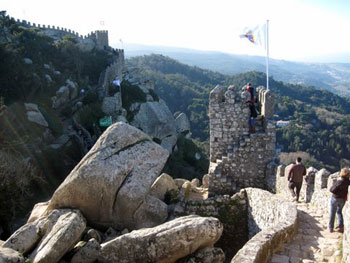 nce I reach the battlements, I can see undulating land disappearing in the distance beyond the stone walls. The Portuguese flag and the Moorish banner flutter in the cool winter breeze. It felt damp and cold in the shade but warm –too warm to wear a jacket- out in the sun. The turrets and keep glowed in the afternoon light, in sharp contrast with the darkness created by the dense vegetation below.
nce I reach the battlements, I can see undulating land disappearing in the distance beyond the stone walls. The Portuguese flag and the Moorish banner flutter in the cool winter breeze. It felt damp and cold in the shade but warm –too warm to wear a jacket- out in the sun. The turrets and keep glowed in the afternoon light, in sharp contrast with the darkness created by the dense vegetation below. The Moorish invaders began to build what is now known as the Moorish Castle (Castelo dos Mouros) in the 8th century. Its vantage point at the top of the hill is a perfect defensive position. It’s easy to imagine the sentries marching along the walls, keeping an eye out for the Christian armies. And it is equally easy to picture the hosts of King Afonso VI swarming up the hills in 1093 in a successful attempt to take Sintra from the Moors. The fortress changed hands between Moors and Christians a few times more until Lisbon was conquered by Dom Afonso Henriques (the first king of Portugal) in 1147, when the Moors surrendered the castle to him.
The Moorish invaders began to build what is now known as the Moorish Castle (Castelo dos Mouros) in the 8th century. Its vantage point at the top of the hill is a perfect defensive position. It’s easy to imagine the sentries marching along the walls, keeping an eye out for the Christian armies. And it is equally easy to picture the hosts of King Afonso VI swarming up the hills in 1093 in a successful attempt to take Sintra from the Moors. The fortress changed hands between Moors and Christians a few times more until Lisbon was conquered by Dom Afonso Henriques (the first king of Portugal) in 1147, when the Moors surrendered the castle to him.
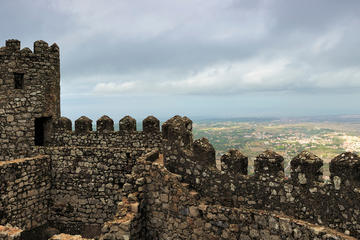
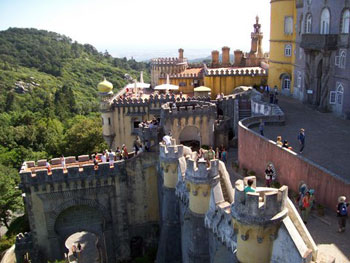
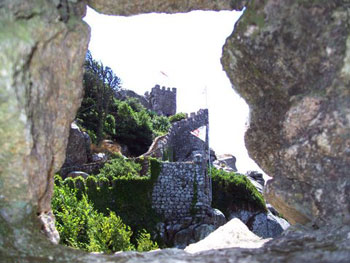 Looking south standing under a mountain-top cross surrounded by lush vegetation in Sintra’s Romantic-period Pena Palace park I wondered if the human construction in the distance was Lisbon. Then I saw a red bridge glinting in the sun, confirming it was Portugal’s capital city twenty-five miles away on the Tagus estuary. It could have been the Golden Gate bridge signalling San Francisco, but I was a long way from California; and the previous day I’d passed the 25 April bridge and a Rio-style Christ statue on the way to Belem, where Portuguese sailors departed on their most famous voyages of discovery.
Looking south standing under a mountain-top cross surrounded by lush vegetation in Sintra’s Romantic-period Pena Palace park I wondered if the human construction in the distance was Lisbon. Then I saw a red bridge glinting in the sun, confirming it was Portugal’s capital city twenty-five miles away on the Tagus estuary. It could have been the Golden Gate bridge signalling San Francisco, but I was a long way from California; and the previous day I’d passed the 25 April bridge and a Rio-style Christ statue on the way to Belem, where Portuguese sailors departed on their most famous voyages of discovery. A half-fish, half-man statue; an allegory for the creation of the world; greets visitors to the central courtyard of the Pena Palace. Entering the Manueline Cloister to view the living quarters, the sun was almost directly above a tall green plant rising out of a grey turtle-stoned pot in the centre of the unroofed inner courtyard. Upstairs, we could walk past the open bedrooms, which were surprisingly small; and through the communal rooms, which were as stylish as expected. Other highlights of the palace included the small ancient chapel, the Great Royal Hall and the kitchen; the latter now houses a cafe, with an outside terrace.
A half-fish, half-man statue; an allegory for the creation of the world; greets visitors to the central courtyard of the Pena Palace. Entering the Manueline Cloister to view the living quarters, the sun was almost directly above a tall green plant rising out of a grey turtle-stoned pot in the centre of the unroofed inner courtyard. Upstairs, we could walk past the open bedrooms, which were surprisingly small; and through the communal rooms, which were as stylish as expected. Other highlights of the palace included the small ancient chapel, the Great Royal Hall and the kitchen; the latter now houses a cafe, with an outside terrace.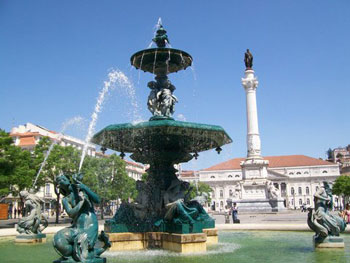 On the way up to the palace I had visited the Moorish Castle. It is now mostly just a long wall with towers above foundations being archaeologically excavated, but it still inspires the imagination, and provides the best views on the mountain of Sintra and the northern plain. The castle was built in the eighth and ninth centuries during the Moors’ occupation of the region, before Portuguese forces regained control in the eleventh century. You can buy tickets for both the castle and Pena Palace at the castle entrance. The castle provides a good break if walking from Sintra to the palace. There are also regular buses.
On the way up to the palace I had visited the Moorish Castle. It is now mostly just a long wall with towers above foundations being archaeologically excavated, but it still inspires the imagination, and provides the best views on the mountain of Sintra and the northern plain. The castle was built in the eighth and ninth centuries during the Moors’ occupation of the region, before Portuguese forces regained control in the eleventh century. You can buy tickets for both the castle and Pena Palace at the castle entrance. The castle provides a good break if walking from Sintra to the palace. There are also regular buses. Lisbon’s train station for Sintra is the Rossio, which is conveniently also the city’s most central. Sintra was the only time I used the train service in Lisbon, as I travelled between Lisbon and the south coast by bus; the Eva service was comfortable and punctual, but there were no toilets or rest-stops on the three-hour journey.
Lisbon’s train station for Sintra is the Rossio, which is conveniently also the city’s most central. Sintra was the only time I used the train service in Lisbon, as I travelled between Lisbon and the south coast by bus; the Eva service was comfortable and punctual, but there were no toilets or rest-stops on the three-hour journey.
 The Chiado is a popular area of Lisbon, between the city centre; Baixa; and the Bairro Alto district. The latter’s narrow cobbled streets and balconied houses ooze age and character. Everything is in easy walking distance, with the Baixa’s plazas interconnected by picturesque streets, squares and statues. The area was rebuilt after a big earthquake in 1755. Restaurants with smartly dressed waiters and waitresses frame the plazas, continue up the eastern hill towards St. George’s Castle, and down to the Tagus a few blocks to the south.
The Chiado is a popular area of Lisbon, between the city centre; Baixa; and the Bairro Alto district. The latter’s narrow cobbled streets and balconied houses ooze age and character. Everything is in easy walking distance, with the Baixa’s plazas interconnected by picturesque streets, squares and statues. The area was rebuilt after a big earthquake in 1755. Restaurants with smartly dressed waiters and waitresses frame the plazas, continue up the eastern hill towards St. George’s Castle, and down to the Tagus a few blocks to the south.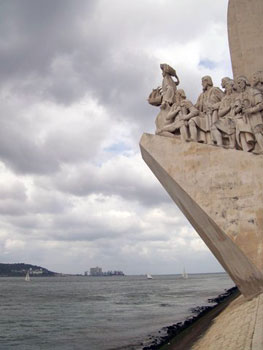 Maybe the sailors sometimes imagine they are Henry the Navigator or Vasco da Gama as they sail out to sea. Henry was a 15th century royal who is credited with being instrumental in developing Portugal’s most rewarding era of exploration and trade. His statue looks out over the Tagus at the head of the impressive Monument to the Discoveries. Behind him are thirty-two notable figures from that era, with sixteen on each side of the caravel-shaped structure; the caravel boat revolutionised Portuguese sailing after being designed with sponsorship from Henry.
Maybe the sailors sometimes imagine they are Henry the Navigator or Vasco da Gama as they sail out to sea. Henry was a 15th century royal who is credited with being instrumental in developing Portugal’s most rewarding era of exploration and trade. His statue looks out over the Tagus at the head of the impressive Monument to the Discoveries. Behind him are thirty-two notable figures from that era, with sixteen on each side of the caravel-shaped structure; the caravel boat revolutionised Portuguese sailing after being designed with sponsorship from Henry.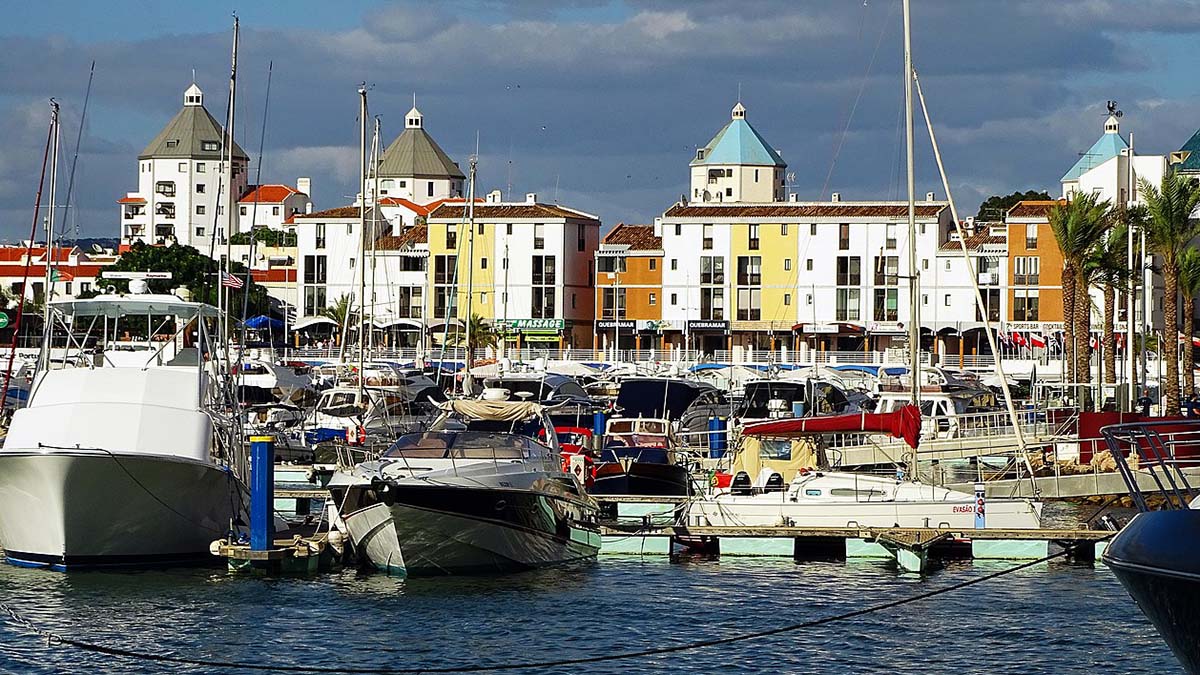
 In 1418 Henry the Navigator became Governor of the Algarve, although at the time he was only plain Prince Henry. He founded a School of Navigation in the town of Sagres, which helped to put Portugal on the map in terms of seafaring and plotting long voyages on the ocean waves. Sadly the school was destroyed by the army of Sir Francis Drake in 1587. Henry the Navigator’s other achievements were to discover new territories in Cape Verde, Madeira, Sierra Leone and the Azores.
In 1418 Henry the Navigator became Governor of the Algarve, although at the time he was only plain Prince Henry. He founded a School of Navigation in the town of Sagres, which helped to put Portugal on the map in terms of seafaring and plotting long voyages on the ocean waves. Sadly the school was destroyed by the army of Sir Francis Drake in 1587. Henry the Navigator’s other achievements were to discover new territories in Cape Verde, Madeira, Sierra Leone and the Azores.